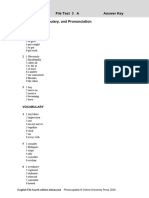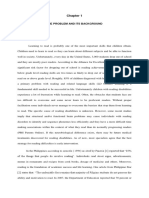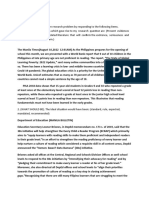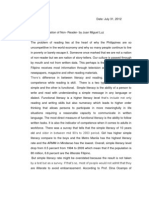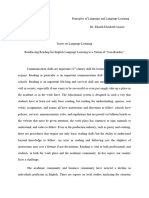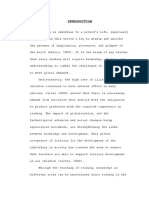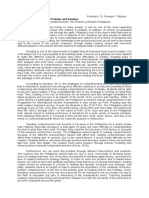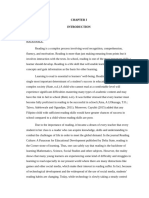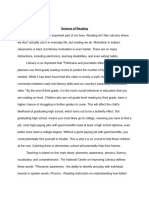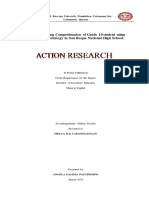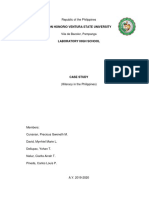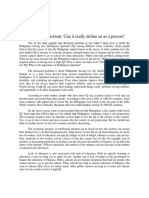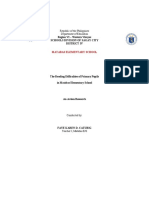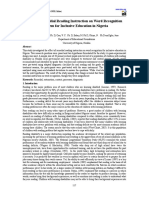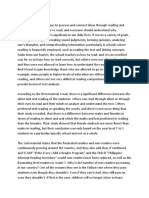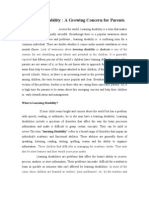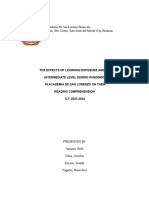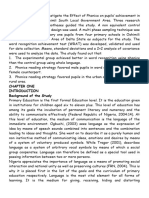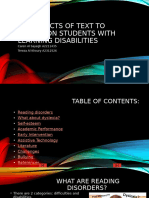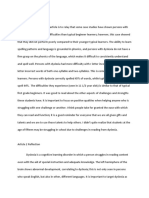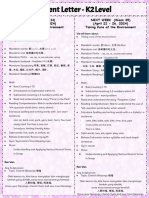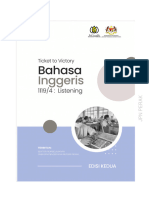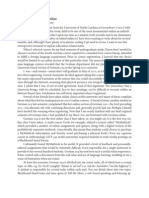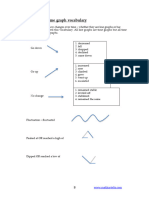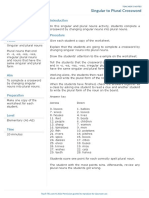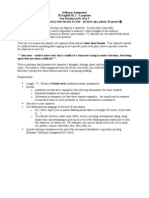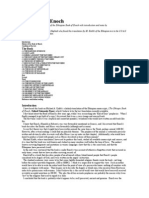Edublox Home
Edublox Home
Uploaded by
Beverly MedezCopyright:
Available Formats
Edublox Home
Edublox Home
Uploaded by
Beverly MedezCopyright
Available Formats
Share this document
Did you find this document useful?
Is this content inappropriate?
Copyright:
Available Formats
Edublox Home
Edublox Home
Uploaded by
Beverly MedezCopyright:
Available Formats
EdubIox Home I Magazine Home I Links I Contact Us
Home Reading Help: Help for Reading Problems and Reading Difficulties
Help for Reading Problems and Reading
Difficulties
Reading and learning are the two things that determine the success of a
child during his school career. First he learns to read. Then he reads to
learn. Because the child with reading problems and reading difficulties
battles to read, he is therefore also hampered in the learning situation.
UnIortunately poor reading skills, and thereIore poor learning skills, have
become a reality Ior an alarming number oI children. In an American study in
1998, the National Assessment Governing Board tested students nationwide and
rated their reading abilities at Iour levels: Below Basic, Basic, ProIicient, and
Advanced. Thirty-eight percent oI Iourth grade students were rated Below
Basic. In the same study, only 31 oI students were at or above the acceptable
level oI ProIicient. Considering that 11 oI students were untestable due to
learning disabilities or language barriers, it implies that approximately 44 oI Iourth grade students are
illiterate and only 25 are reading at an acceptable level!
HOW TO IDENTIFY READING PROBLEMS AND READING DIFFICULTIES
The signs or symptoms below indicate that a child has a reading problem and thereIore needs help:
O ne oI the most obvious and a common telltale sign is reversals. Children with this kind oI
problem oIten conIuse letters like b and d, or they sometimes read words like rat Ior tar,
or won Ior now.
O Another sure sign, which needs no conIirmation by means oI any Iorm oI testing, is elisions, that is
when a child sometimes reads .at when the word is actually .art.
O The child who reads very slowly and hesitantly, who reads without Iluency, word by word, or who
constantly loses his place, thereby leaving out whole chunks or reading the same passage twice, has
a reading problem.
O The child may try to sound out the letters oI the word, but then be unable to say the correct word.
For example, he may sound the letters .at but then say.old.
O e may read the letters oI a word in the wrong order, like left Ior felt, or the syllables in the wrong
order, like emeny Ior enemy, or words in the wrong order, like are there Ior there are.
O e may read with poor comprehension, or it may be that he remembers little oI what he reads.
FIND THE CAUSE TO FIND A CURE
SuccessIul intervention is dependent on Iinding the cause or causes oI a problem. Most problems can only be
solved iI one knows their causes. A disease such as pellagra, also called the disease oI the Iour D`s
dermatitis, diarrhea, dementia and death took the lives oI thousands in the Southern states oI America
during the early part oI the twentieth century. Today, pellagra is virtually unknown because we know that it
is caused by a vitamin B3 deIiciency. A viable point oI departure would thus be to ask the question, hat
.auses reading problems and reading diffi.ulties?`
To Iully understand the cause oI reading problems it is important to take note oI the Iact that there is nothing
that any human being knows, or .an do, that he has not learned. II you dump a little puppy into the water, it
will swim. Do the same with a human child, and it will drown. The child must learn to swim.
There is yet another, equally important Iact, which is also a sine qua non towards the understanding oI
reading problems, and which has also so Iar been overlooked, viz.that learning is
a stratified pro.ess. This is a selI-evident Iact, yet its signiIicance in the situation
oI the child with a reading problem has apparently never been Iully
comprehended. Throughout the world in all educational systems it is commonly
accepted that a child must start at the lower levels oI education and then gradually
progress to the higher levels. II human learning had not been a stratiIied process, iI
it had taken place on a single level, this would have been unnecessary. It would
then not have been important to start a child in Iirst grade. It would have been
possible Ior the child to enter school at any level and to complete the school years
in any order.
A simpler example to illustrate the stratiIied nature oI learning is the Iact that one
has to learn to count beIore it becomes possible to learn to add and subtract.
Suppose one tried to teach a child, who had not learned to count yet, to add and subtract. This would be quite
impossible and no amount oI eIIort would ever succeed in teaching the child these skills. In the same way,
there are also certain skills and knowledge that a child must have acquired 1789-01470 it becomes
possible for him to benefit from a course in reading.
Edublox oIIers cognitive training programs, aimed at developing and automating the Ioundational skills that
are required not only in reading, but also in spelling, writing, mathematics and the skills required in the
learning oI subject matter. Examples oI these are:
O Concentration
O Accurate perception
O 'isual discrimination oI Ioreground-background
O 'isual discrimination oI Iorm
O 'isual discrimination oI size
O 'isual discrimination oI position in space
O 'isual discrimination oI color
O 'isual analysis oI position in space
O Auditory discrimination oI Ioreground-background
O Auditory discrimination oI position in time and space
O Auditory discrimination oI color
O Auditory analysis oI position in time and space
O Auditory synthesis oI position in time and space
O 'isual discrimination oI dimensionality
O Decoding and integration oI inIormation
O 'isual closure
O Imagination
O 'isual memory oI Iorms
O 'isual memory oI sequence
O Auditory memory
O Short-term memory
O ong-term memory
O Concept oI numbers
O #easoning
O ogical thinking
O Fine motor coordination
O Gross motor coordination
O Sensory motor integration
By addressing these Ioundational skills, reading problems and reading diIIiculties and other learning
diIIiculties can be overcome and prevented.
Home A B C D E F G H I J K L M N O P Q R S T U V W X Y Z
ow proficiency in reading comprehension may threaten
global competitiveness
(The Philippine Star) Updated February 22, 2010 12:00 AM Comments (0)
MANILA, Philippines - It is conventional wisdom to think that our competency in English gives us a clear-cut
advantage in the BPO (business process outsourcing) industry. After all, English is practically our second
language, so doing business with Westerners should not pose a problem at all. This kind of readiness has
made us a worthy competitor in the global business arena.
owever, recent National Achievement Tests (NAT) administered to public schools paint a picture that may
threaten that competitiveness. The DepEd reports that there has been a 21.36 percent increase in NAT
results from 2006 to 2009. The 2009 NAT revealed a rise in Mean Percentage Score (MPS) of only 66.33
percent from 54.66 percent in 2006, which equates to an improvement of 11.67 percent. The percentage
gains were in all subject areas and point to a steady improvement in the primary education of the countrys
public school system.
So this kind of progress is supposed to be a good thing, right?
Maybe. Maybe not. Because a 66.33 MPS (from 54.66 in 2006) is still a rather low score. In fact, its at the
"near mastery level. Whats more alarming is that mastery is only at 14.4 percent among grade 6 students
and 1.1 percent among fourth-year high school students, which means below-mastery scores are a
staggering 85.6 percent among the former and 98.1 percent among the latter.
What could be the reason for such "below mastery levels? In a 2007 interview, Dr. Yolandda Quijano, head
of the DepEds Bureau of Elementary Education, attributed "reading problems as the main culprit for the
poor performance of some students in the NAT.
This is definitely a cause for alarm because if the upcoming generation cannot read properly, then there is a
big chance they will have difficulty writing and speaking well - simple but vital tasks in maintaining that
competitive edge in BPO work. If a new generation of professionals is plagued with poor reading
comprehension - and all of its consequential handicaps - our share of the BPO market could very well
shrink.
To address this concern at its very core, students have to be trained at the earliest age to read well. This
means access to a wide variety of quality books at their schools and a program that encourages reading for
pleasure - because the surefire way to develop good reading comprehension is by making reading a habit.
Doing so will ensure that our upcoming generation and those after that will be prepared for any challenges
that lie ahead. After all, you cant go wrong with a generation of good readers to take care of business.
TransitionaI Reading ProbIems in EngIish in a PhiIippine BiIinguaI Setting
ndrew Gonzalez and Teresita C. Rafael
The Reading Teacher
Vol. 35, No. 3 (Dec., 1981), pp. 281-286
(article consists of 6 pages)
Published by: nternational Reading ssociation
Stable URL: http://www.jstor.org/stable/20197977
Home I Products I Success Stories I ArticIes I OnIine Shop I Contact Us
Home Reading Problems in Children Explained
Reading Problems in Children Explained
America is supposed to be one oI the most aIIluent and technologically advanced societies in the world. Free
public education is available in every nook and cranny oI this country, and the Iederal government spends an
estimated $10 billion every year battling illiteracy.
So why do Americans have such problems with reading?
The $14 million National Adult iteracy Survey oI 1992 Iound that even though most adults in this survey
had Iinished high school, 96 oI them could not read, write and Iigure well enough to go to college. Even
more to the point, 25 "were plainly unable to read," period.
#esults oI the 2003 National Assessment oI Adult iteracy (renamed Irom 1992) Iound that reading
comprehension levels did not signiIicantly change between 1992 and 2003 and that there was little change in
adults' ability to read and understand sentences and paragraphs.
Surely this is unacceptable. Imagine doing a survey on the building industry and
Iinding that the walls oI 96 oI all homes are severely cracked, and that in 25 oI
the houses the walls are so weak that they collapse. Wouldn't we immediately start
an investigation into the building practices oI the builders? Wouldn't we check
whether they were careIul to provide proper Ioundations Ior these homes?
We all know that beIore building a house, one needs to lay a Ioundation. Unless
there is a strong and solid Ioundation, cracks will soon appear in the walls, and
with no Ioundations, the walls will collapse. In the same way one needs to lay a
proper Ioundation beIore it becomes possible Ior a child to beneIit Irom a course in
reading. II this Ioundation is shaky, learning "cracks" will soon appear.
anguage: The First #ung oI the #eading adder
It is important to note that learning is a stratiIied process, in which one skill has to be acquired first, before it
becomes possible to acquire subsequent skills. It is like climbing a ladder, iI you miss one oI the rungs you
will Iall oII.
Di dunia kini kita, tiap orang harus dapat membaca.... Unless one has FI#ST learned to speak Bahasa
Site Content
Products
What Is Audiblox?
Audiblox Home Kit
Compublox
Schoolblox
Success Stories
Testimonials, Case
Studies, Video Clips and
More
Articles
Online Shop
Contact Us
USA & Canada:
Susan du Plessis
Australia:
Corna Wynne
08-9848 3673
India:
Shalini Mehta
(22) 9920080460
South Africa:
Contact an Edublox Clinic
atwww.edublox.co.za
Elsewhere:
Susan du Plessis
Indonesia, there is no way that one would be able to read the above Indonesian sentence.
This shows that language is at the very bottom oI the reading ladder. Its role in the acquisition oI reading can
be compared to the role oI running in the game oI soccer or ice-skating in the game oI ice hockey. ne cannot
play soccer iI one cannot run, and one cannot play ice hockey iI one cannot skate. ne cannot read a book in
a language unless one knows the particular language.
II a child's knowledge oI English is poor, then his reading will also be poor. Without eIIectively working at
improving his English, the reading ability oI the child will notimprove.
Cognitive Skills: The Second #ung
While language skills comprise the Iirst rung oI the reading ladder, there are a large number oI cognitive
skills that comprise the second.
The reading process can be divided into three steps: Re.eption, de.oding andlearning. A schematic diagram
oI the act oI reading is presented below, as well as a detailed explanation oI the diagram:
Home Page
Reception:
There are many Iactors involved in the reception oI the written word. The Iirst is that a person must be able to
Iocus his attention on the written word and to keep his attention on it Ior some length oI time. This is
called .on.entration.
Concentration rests on two legs. First, it is an a.t of will and cannot take place automatically. The will to
Iocus attention on the written word must be sustained in order to carry out all the actions needed to Iully
comprehend it. Second, it is also a skill, and thereIore has to be taught.
The next step in receiving the written word is that it must be perceived. In other words, per.eption must take
place.
BeIore one can learn anything, one has to become aware oI it through one oI the senses. Usually one has to
hear or see it. Subsequently one has to interpretwhatever one has seen or heard. In essence then, perception
means interpretation. I course, lack oI experience may cause a person to be liable to misinterpretation oI
what he has seen or heard.
Perception in itselI consists oI a large number oI subskills, that can all be automatized. There are various
ways oI perceptualizing, namely visual, auditory and haptic. The latter includes touch perception and
kinesthetic perception. Because we read with our eyes, visual perception plays the most important role in the
reading act.
When a person is reading, visual dis.rimination must take place. All printed letters are set against a certain
background. The most important diIIerence between the letters and the background is that they diIIer in color.
bviously, the Iirst discrimination will thus be in terms oI .olor. The second discrimination is in terms
oI foregroundba.kground. The particular letter, or word, or sentence, that the reader is Iocused on is elevated
to the level oI Ioreground, whereas everything else within the Iield oI vision oI the reader (the rest oI the page
and the book, the desk on which the book is resting, the section oI the Iloor and/or wall that is visible, etc.) is
relegated to the background. ur atin alphabet consists oI 26 letters, each with its corresponding capital
letters with a diIIerence in size and sometimes in shape compared to the lower case counterpart. The letters
all diIIer in form or shape and must be discriminated accordingly. Capital letters sometimes look exactly the
same as their lower case counterparts, and must thereIore be discriminated mainly with regard to si:e. ne
also does not only read letters, but thoughts, all compiled Irom a conglomeration oI words. A word is made
up oI a number oI letters arranged in a particular sequence. The reader must thereIore be able to discriminate
the letters in terms oI theirpositions. II a sketch or picture is included in the text, there must be discrimination
oIdimensionality as well.
AIter having discriminated every letter in terms oI color, Ioreground and background, Iorm, size and position,
letters must be combined into words. The reader must be able to perceive individual parts as a whole. In other
words, he must be able tosynthesi:e.
Although the ability to analy:e, i.e. to perceive the whole in its individual parts, does play a role in reading,
this ability is oI special importance in spelling. To be a good speller, one must be able to analy:e.
The above events sound very complex, and indeed must be recognized as being just that. In reality they take
place all the time at lightning speed while a person is reading, but a good reader is unaware oI these
events because they have been automatized. It can be compared to a Spaniard speaking Spanish while doing
other things because his knowledge oI the language has been automatized through regular practice and usage.
While speaking, he is not concentrating on grammar, word order, sentence structure, and things like that, but
on the contents oI what he wants to say. This is only possible because his language has become automatized.
Decoding:
When a person attempts to speak a language that has not become automatic yet,
he will necessarily have to divide his attention between the content oI his
message and the language itselI. e will thereIore speak haltingly and with great
diIIiculty just as a person, in whom the above-mentioned Ioundational skills oI
reading have not yet become automatized, also reads haltingly and with great
diIIiculty. The poor reader is Iorced to apply all his concentration to the reception
oI the written word, and thereIore has "no concentration leIt" to decode it. Every
little piece oI butter can only be spread on a certain size oI bread.
Decoding is a very important aspect oI the reading act. Without being able to
decode the written word, the reader cannot understand it. This explains why some
children "read" without understanding what they are reading.
Decoding implies that the reader is able to decipher the written word, in other words, he is able to ascribe
meaning to it. This becomes possible Iirst by integrating what he is reading with his Ioreknowledge.
Foreknowledge can be deIined as the range oI one's existing knowledge and past experiences.
A decoding skill that is closely related to that oI integration,
is .lassifi.ation. When a person sees a chair, although he may never have
seen a chair exactly like this one, he will nevertheless immediately
recognize it as a chair, because he is Iamiliar with the .lass oI objects we
call "chair." This implies that, whenever a name is ascribed to an object, it
is thereby put into a speciIic class oI objects, or it is classiIied.
The Gestalt principle oI .losure means that the mind is able to derive
meaning Irom objects or pictures that are not perceived in Iull. I -m s-re th-
t y-- w-ll b- -ble to und-rsta-d th-s s-ntenc- (I am sure that you will be able
to understand this sentence), although more than 25 percent oI the letters
have been omitted. The mind is quite able to bridge the gaps that were leIt
in the sentence. The idea oI closure is, however, more than just seeing parts oI a word and ampliIying them. It
also entails the ampliIication oI the author's message. No author can put all his thoughts into words. This
stresses the importance oI Ioreknowledge. II it were possible Ior an author to put everything related to the
subject he is dealing with on paper, Ioreknowledge would have been unnecessary. That, however, is
impossible, as an author can at most present us with a very limited cross-section oI reality and the reader must
be able to expand this beIore comprehension becomes possible.
astly, imagination plays a role in decoding. While one is reading, one is also picturing the objects and ideas
symbolized by the words. Should the author describe a beautiIul landscape, one would actually picture this in
the mind's eye. ne does not merely see the pictures called to mind by the respective words, one also sees the
scene. This plays a very important role in decoding the written word. Furthermore, by using one's imagination
while reading, one's emotions can be addressed during the reading act.
Learning:
nly aIter a person has decoded the written word can learning take place. To learn, a person must be able to
store something that he has perceived and decoded, so that he will be able to recall this inIormation at a later
stage. The ability to re.all to memory or to remember, makes learning possible.
Memory is one oI the Ioundational skills oI learning which is oI special importance in the so-called learning
subjects at school or university, where inIormation is presented to the learner, and it is expected that he be
able to reproduce it as accurately as possible. owever, memory is a skill that is also oI great importance to
the reading act. For example, recognizing the shapes oI the diIIerent letters comprising a particular word, is
an act oI memory. Every word also consists oI letters in a particular sequence, and one has to remember what
word is represented by the sequence oI letters in question.
Language Problems:
Not all children with reading problems have language problems. II, however,
you suspect that your child has a language problem, read the article "ow to
vercome a anguage Problem."
Deficits in Cognitive Skills:
The majority oI children with reading problems have deIicits in cognitive
skills. Audiblox and Compublox aim at developing and automatizing the
cognitive skills required Ior reading.
You might also like
- Key To English File Test For Unit 3Document3 pagesKey To English File Test For Unit 3María GómezNo ratings yet
- Is Younger Better (Read)Document8 pagesIs Younger Better (Read)Laura Souza100% (2)
- Action ResearchDocument11 pagesAction ResearchMaribel Cabaya Soliven0% (1)
- Your Child Can't Read Because His Teacher Cannot Teach Phonics Reading SkillsFrom EverandYour Child Can't Read Because His Teacher Cannot Teach Phonics Reading SkillsNo ratings yet
- Why Is Reading ImportantDocument15 pagesWhy Is Reading ImportantGe LoNo ratings yet
- Synthesis Paper: Reading Difficulties, Disabilities, or ProblemsDocument5 pagesSynthesis Paper: Reading Difficulties, Disabilities, or ProblemsJozelle Grace PadelNo ratings yet
- Dissertation IntroductionDocument3 pagesDissertation IntroductionAnonymous 0FWhoTuNo ratings yet
- Research Title 1Document4 pagesResearch Title 1Kristel Ariane AguantaNo ratings yet
- Article 2 - A Nation of Non ReaderDocument5 pagesArticle 2 - A Nation of Non ReaderJackie HerreraNo ratings yet
- Issues On Language LearningDocument6 pagesIssues On Language LearningJohn Kevin Carmen SamsonNo ratings yet
- Chapter I - 2editDocument17 pagesChapter I - 2editabegail libuitNo ratings yet
- Grade 6 Students' Perception On Their Reading Comprehension Level: An Action ResearchDocument35 pagesGrade 6 Students' Perception On Their Reading Comprehension Level: An Action ResearchAljeya EvanchezNo ratings yet
- Strategies Utilized in Reading RemediationDocument23 pagesStrategies Utilized in Reading Remediationarlene landocan100% (2)
- Expository Form of Writing-Keth A. VillanuevaDocument1 pageExpository Form of Writing-Keth A. VillanuevaKeth Arcilla VillanuevaNo ratings yet
- Read Well, Think Well: Build Your Child's Reading, Comprehension, and Critical Thinking SkillsFrom EverandRead Well, Think Well: Build Your Child's Reading, Comprehension, and Critical Thinking SkillsRating: 3 out of 5 stars3/5 (1)
- Introduction To Elementary LiteracyDocument8 pagesIntroduction To Elementary LiteracyAshish BansalNo ratings yet
- Key Social Economic Literacy IndicatorsDocument2 pagesKey Social Economic Literacy IndicatorsETYMONo ratings yet
- Reading Challenges - Journal TypeDocument14 pagesReading Challenges - Journal Typejonalyn obinaNo ratings yet
- dayton1342731719Document44 pagesdayton1342731719marivic.catalunaNo ratings yet
- Pr Chapter iDocument12 pagesPr Chapter ijohartobadal01No ratings yet
- Science of Reading (Not About Science... More On Phonics and Opinion)Document9 pagesScience of Reading (Not About Science... More On Phonics and Opinion)Daniel GarciaNo ratings yet
- Chapter 2Document23 pagesChapter 2Sophia CaitNo ratings yet
- Illiteracy and Its SolutionsDocument2 pagesIlliteracy and Its Solutionshongchi9905No ratings yet
- Reading Challenges and Strategies of NonDocument14 pagesReading Challenges and Strategies of NonShella May Manatad BaringNo ratings yet
- Affect and Adolescents With Severe Reading DisabilitiesDocument8 pagesAffect and Adolescents With Severe Reading DisabilitiesCliutaNo ratings yet
- Science of Reading Paper - Edu210Document6 pagesScience of Reading Paper - Edu210api-741424880No ratings yet
- Reading Is The Mother of Any Ability To StudyDocument34 pagesReading Is The Mother of Any Ability To StudyCHRNo ratings yet
- The Problem and Its BackgroundDocument113 pagesThe Problem and Its BackgroundLyll Caren SanchezNo ratings yet
- Language Handicaps in Children PDFDocument7 pagesLanguage Handicaps in Children PDFErsya MusLih AnshoriNo ratings yet
- Phonics Is The Solution Dispro Summitt TOTAL FINALDocument55 pagesPhonics Is The Solution Dispro Summitt TOTAL FINALRissa CoronelNo ratings yet
- Special Needs A CopiedDocument52 pagesSpecial Needs A CopiedTorter biditNo ratings yet
- Develop Reading Comprehension of Grade 10 Student Using Visualization Strategy in San Roque National High SchoolDocument17 pagesDevelop Reading Comprehension of Grade 10 Student Using Visualization Strategy in San Roque National High SchoolAnjela Galima PasatiempoNo ratings yet
- SUPER FINAL Illiteracy Case StudyDocument15 pagesSUPER FINAL Illiteracy Case StudyJo PinedaNo ratings yet
- EssayDocument3 pagesEssayMN FerueloNo ratings yet
- School Success for Kids with Dyslexia and Other Reading DifficultiesFrom EverandSchool Success for Kids with Dyslexia and Other Reading DifficultiesRating: 3.5 out of 5 stars3.5/5 (9)
- About DyslexiaDocument4 pagesAbout DyslexiaFauzan FaridNo ratings yet
- Levels I Abstraction of LanguageDocument12 pagesLevels I Abstraction of LanguageYugal ShresthaNo ratings yet
- Reading Problems Among The Grade Seven StudentsDocument5 pagesReading Problems Among The Grade Seven StudentsRaymund MontoyaNo ratings yet
- Nov10Faye Karen D. Catubig - Proposal DefenseDocument26 pagesNov10Faye Karen D. Catubig - Proposal DefenseFaye Karen D. CatubigNo ratings yet
- Language Barriers DissertationDocument5 pagesLanguage Barriers DissertationWriteMyPaperOnlineNewark100% (1)
- Early Literacy and Numeracy MattersDocument20 pagesEarly Literacy and Numeracy MattersSjkt Ladang Kelapa Bali100% (2)
- The Missing Link in Reading Comprehension Jason CarosDocument19 pagesThe Missing Link in Reading Comprehension Jason CarosrebidellNo ratings yet
- Language Processing Problems: A Guide for Parents and TeachersFrom EverandLanguage Processing Problems: A Guide for Parents and TeachersNo ratings yet
- About Dyslexia & Reading ProblemsDocument21 pagesAbout Dyslexia & Reading Problemschiara21No ratings yet
- Thesis On Mother Tongue BasedDocument7 pagesThesis On Mother Tongue Basedanaespinalpaterson100% (2)
- Thesis About Mother Tongue Based EducationDocument8 pagesThesis About Mother Tongue Based Educationkimstephenswashington100% (2)
- Effect of Remedial Reading Instruction On Word Recognition Problem For Inclusive Education in NigeriaDocument9 pagesEffect of Remedial Reading Instruction On Word Recognition Problem For Inclusive Education in NigeriaJho Lei BheeNo ratings yet
- TCT Univspeak 11-18 UpdateDocument32 pagesTCT Univspeak 11-18 Updatetransicion videosNo ratings yet
- What Is ReadingDocument3 pagesWhat Is ReadingRIZA COSNo ratings yet
- Fair Dealing (Short Excerpt)Document64 pagesFair Dealing (Short Excerpt)ManYee KatieNo ratings yet
- Learning Disability: A Growing Concern For ParentsDocument11 pagesLearning Disability: A Growing Concern For ParentsFilja JohnNo ratings yet
- Why Our Kids Cant ReadDocument10 pagesWhy Our Kids Cant Readapi-559290813No ratings yet
- IELTS Test PreparationDocument5 pagesIELTS Test PreparationAnna100% (1)
- Kumbakonam IMA2018 Learning DisabilityDocument9 pagesKumbakonam IMA2018 Learning DisabilityDr.V.SivaprakasamNo ratings yet
- Thesis About Reading Difficulties in The PhilippinesDocument8 pagesThesis About Reading Difficulties in The Philippinesafknmwhjn100% (1)
- Helping Your Dyslexic Child & Struggling Reader At Home A Parent GuidebookFrom EverandHelping Your Dyslexic Child & Struggling Reader At Home A Parent GuidebookNo ratings yet
- Research Chap1 4Document44 pagesResearch Chap1 4TAMAYO, Ruth P.No ratings yet
- Work Assignment WordDocument8 pagesWork Assignment Wordbedeokwaraji1No ratings yet
- The Effects of Text To Speech On Students - AlsayeghCaren - AlkhouryterezaDocument12 pagesThe Effects of Text To Speech On Students - AlsayeghCaren - Alkhouryterezacarensayegh14No ratings yet
- DyslexiaDocument3 pagesDyslexiaapi-425125575No ratings yet
- Body Language Power Point PresentationDocument22 pagesBody Language Power Point PresentationK.Subramanyam100% (8)
- C Programming Decision MakingDocument27 pagesC Programming Decision MakingKartheeban KamatchiNo ratings yet
- Knowing God's VisionDocument5 pagesKnowing God's VisionCaithness BlogNo ratings yet
- Unit 2 - OverfishingDocument8 pagesUnit 2 - OverfishingMasayu RahmadaniNo ratings yet
- Digital Logic Lab ManualDocument81 pagesDigital Logic Lab ManualArslan Majid100% (1)
- Week 34Document9 pagesWeek 34erlinda.natalia.brownieNo ratings yet
- Ladino & Sephardic CultureDocument48 pagesLadino & Sephardic Culturechrystek007100% (1)
- 1.legal SLR 3045Document7 pages1.legal SLR 3045ANKUSH FREE FIRENo ratings yet
- Comparative DegreeDocument7 pagesComparative DegreeEvitiaaNo ratings yet
- Brog PaDocument27 pagesBrog PaIsaac CampbellNo ratings yet
- Victory Listening ModuleDocument50 pagesVictory Listening Moduleg-05288283No ratings yet
- University Learning OnlineDocument4 pagesUniversity Learning OnlineThomas HopkinsNo ratings yet
- RECAP Graph VocabularyDocument5 pagesRECAP Graph VocabularySlyder27No ratings yet
- Perspectives Upperint Ss FinalDocument2 pagesPerspectives Upperint Ss FinalInKHsNo ratings yet
- Singular To Plural CrosswordDocument2 pagesSingular To Plural CrosswordNatalie SavchenkoNo ratings yet
- Using SWISH To Realise Interactive Web Based Tutorials For Logic Based LanguagesDocument35 pagesUsing SWISH To Realise Interactive Web Based Tutorials For Logic Based LanguagesAxy100% (1)
- Soliloquy Assignment 2012Document4 pagesSoliloquy Assignment 2012Michelle Lampinen0% (2)
- Chuyên đề ngữ pháp Tiếng anh Tiểu học Verb to beDocument10 pagesChuyên đề ngữ pháp Tiếng anh Tiểu học Verb to beThao LuuNo ratings yet
- 11-Error HandlingDocument25 pages11-Error HandlingMuhammad NugrahaNo ratings yet
- 9280 W QP InternationalEnglishasaSecondLanguage G - 240209 - 134528Document10 pages9280 W QP InternationalEnglishasaSecondLanguage G - 240209 - 134528adam.mohamed.ketNo ratings yet
- Almira Vs CA - GR 115966 - Mar 20, 2003Document11 pagesAlmira Vs CA - GR 115966 - Mar 20, 2003Meg VillaricaNo ratings yet
- Instant Download Japanese English Translation An Advanced Guide 1st Edition Judy Wakabayashi PDF All ChaptersDocument62 pagesInstant Download Japanese English Translation An Advanced Guide 1st Edition Judy Wakabayashi PDF All Chapterszoreaarlet100% (3)
- Leadership Communication Group 6 - George Bush's Eulogy AnalysisDocument15 pagesLeadership Communication Group 6 - George Bush's Eulogy AnalysisAmal Fitra Iriansah100% (1)
- Academic Writing HandoutDocument5 pagesAcademic Writing Handoutkhaela tendidoNo ratings yet
- 01 Always - Exercises in HindiDocument5 pages01 Always - Exercises in HindiAnil MahatoNo ratings yet
- Book of EnochDocument45 pagesBook of EnochTorentSpyNo ratings yet
- Philippine Literature in EnglishDocument5 pagesPhilippine Literature in Englishsapabapjava2012100% (1)
- Adnan CVDocument4 pagesAdnan CVNuredin Gensilti'eNo ratings yet
- BĄCZKOWSKADocument358 pagesBĄCZKOWSKAtijayNo ratings yet
